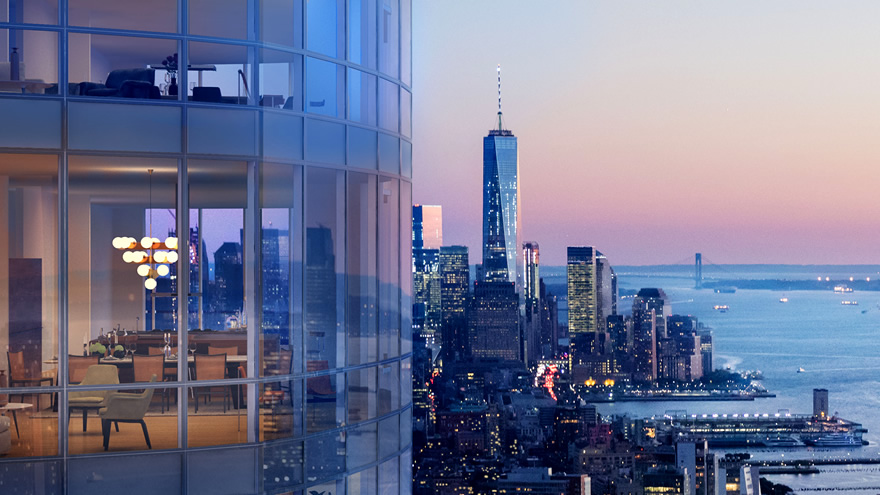
“All About Connectivity & Awareness”
“It’s all about connectivity,” Karba, who is also the co-Founder and CEO of ix-Strata, a sophisticated software engineering and development firm, told us. “There will be an incredible amount of fiber, distributed antenna systems, WiFi,” Karba added.
Further, the systems will draw on myriad sensors and AI to achieve awareness of each individual’s presence, to enhance convenience and provide security. “They will be aware of your profile, your needs and preferences,” Karba stated. As an example, tenants would be allowed to pass through a turnstile without having to pull out a card, the elevator would be ready for him and her and know their floor. They could even arrange to have automatic entry to their apartment.
The systems will also be equipped to understand the environment – temperature, noise levels, air quality, weather. The objective is both to optimize energy consumption and enhance the living experience and the productivity of everyone associated with the area.
“A lot of the enhancements will be developed by the market,” Karba explains. “We provide the connectivity, the awareness. We will have an enterprise services bus that will broker the hundreds of systems in the project and will provide security and analytics.”
Hudson Yards – Getting It Done
How big is this “biggest ever” project and when will it be done? The Yards cover 28 acres between 30th and 34th Streets and 10th and 12 Avenues, basically overlooking the Hudson River on the west. There will ultimately be 4,000-6,000 residents, 14 acres of park space, and dozens of commercial and eating places, as well as a school and other facilities.
Karba explained that it is being constructed in two phases; the first being the eastern yards – between 10th and 11th Avenues. This alone is about a $12 billion project, funded by major global banks. Its construction began in 2014 and should be completed in 2019. It will have one major residential high rise and one mixed occupancy high rise. As of earlier this year, one of the buildings, 10 Hudson Yards, is open for commercial occupancy.
The western yards – between 11th and 12th Avenues – is slated for construction between 2019 and 2026. This sector will be mostly residential, Karba informed us. The total budget for the project is estimated at $22 billion.
Amazingly, the entire project is being built over the existing rail yards, which will remain in operation. (Out-of-services trains that use New York’s nearby Penn Station, are parked there.)
The principal developer has been the Related group, a major global developer and leader in mixed-use development. Karba described the relationship he has had with Related, where he served as CIO, and which led to his appointment as the chief technology officer for the project – this being in addition to his managing his own expert software company, ix-Strata.
ix-Strata – Thriving on Complexity
“If it’s complex and difficult, that’s when we come in,” Karba explains concerning ix-Strata, the firm he co-founded. ix-Strata provides a number of “IT-as-a-service” custom software applications and infrastructure management solutions to a wide range of industries.
“All systems today are designed for the cloud,” he points out. The company has provided solutions for a number of major global companies, but also many newer, Internet apps providers, including:
CompStak
An exchange that allows commercial real estate brokers to swap actual information about recently rented properties, such as rent, lease concessions, term, etc.
RiskMatch
Provides data and analytics about risk issues for use by insurance brokers, agencies and others in the insurance industry.
RealtyMogul
A crowdfunding site that affords the opportunity for individuals and others to invest in real estate.
The company has about 150 people, located primarily in California.
Our Take
The island of Manhattan has had its history of showpiece real estate developments, past notable examples being Rockefeller Center and Battery Park City. Each had its purposes and its technology advances and claims to modernity.
Rockefeller Center
Vintage 1930s; Commercial development; Technology – “New technology was widely used throughout the complex, which for the first time featured high-speed elevators, air conditioning, and an elaborate underground concourse and parking lot.”
Battery Park City
Vintage 1980s (and later continued construction); Largely residential, later considerable commercial; Technology – not a claim of the earlier buildings, but later (post-2000) include “environmentally progressive, green,” energy efficient construction.
Hudson Yards takes the integration of 21st century information technology and building construction to new heights. While real estate folk may wax primarily about some of the striking architectural features – and there certainly are several – we focus on technology and the advancing mobile cloud. It appears to us, particularly in its application of AI and sensors (IoT) Hudson Yards will be an extremely dynamic project and a learning experience for all developments that follow.
Visit their website: www.hudsonyardsnewyork.com
